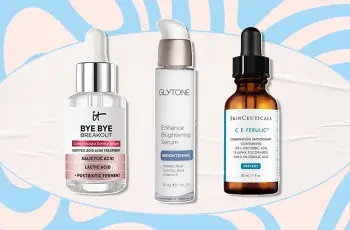
Many skincare enthusiasts are curious about how to combine active ingredients for optimal results. While there are numerous effective combinations, certain potent ingredients can cause irritation when layered, and it’s important to know which ones to avoid using together.
So, can mandelic acid and retinol be used in the same routine? Let’s break down how these two ingredients work on the skin and whether they can be used together safely.
What is Mandelic Acid?
Mandelic acid, a type of alpha-hydroxy acid (AHA), is derived from bitter almonds and is renowned for its gentle exfoliating properties. It’s often recommended for those with sensitive skin due to its larger molecular size, which prevents it from penetrating too deeply and causing irritation.
Hyperpigmentation and Uneven Skin Tone: Mandelic acid is effective at reducing dark spots, melasma, sun damage, and other pigmentation issues, resulting in a more even complexion.
Acne Control: It helps clear clogged pores, dissolves blackheads, and regulates oil production, making it useful for managing acne flare-ups.
Anti-Aging: By removing dead skin cells, mandelic acid can diminish the appearance of fine lines, improve skin elasticity, and leave the skin looking firmer.
Compatibility: It works well with other skincare ingredients when used appropriately, making it easy to incorporate into a routine.
For a deeper dive into mandelic acid, check out our dedicated blog post.
What is Retinol?
Retinol, a potent form of vitamin A, is one of the most effective ingredients in skincare. It accelerates skin cell turnover, helping to shed dead skin cells and reveal smoother, brighter skin.
Cell Turnover: Retinol speeds up the natural exfoliation process, revealing fresher, younger-looking skin.
Collagen Boost: It stimulates collagen and elastin production, resulting in firmer, more plump skin.
Anti-Aging: Retinol helps reduce the appearance of fine lines and wrinkles and minimizes enlarged pores.
Hyperpigmentation: It can reduce signs of sun damage, dark spots, and discoloration, helping to create a more uniform complexion.
For more information on how retinol benefits the skin, visit our detailed post.
Can You Use Mandelic Acid and Retinol Together?
While both mandelic acid and retinol offer impressive benefits, combining them in the same skincare routine can be tricky. These ingredients are both exfoliating, and when used together, they can over-exfoliate the skin, leading to irritation, redness, or dryness.
Over-exfoliating can strip the skin of its natural oils, weakening the skin’s protective barrier. As a result, the skin may produce excess oil in response, which could trigger acne or other skin concerns. To avoid this, here are some tips for using mandelic acid and retinol together:
Alternate Usage: To minimize the risk of irritation, use mandelic acid and retinol on different days or in separate routines (mandelic acid during the day, retinol at night).
Wait Between Applications: If using both in one routine, wait about 10 to 15 minutes between applying each product. This allows the skin’s pH to reset and reduces the chance of irritation.
Consult a Professional: If you’re unsure about how to layer these ingredients, it’s always wise to consult with a dermatologist or skincare professional.
What Should You Avoid Mixing with Mandelic Acid?
Even though mandelic acid is one of the gentler AHAs, it should not be mixed with other strong exfoliants or potent active ingredients, especially retinol. Using these ingredients together could lead to an overstimulated skin barrier and cause irritation or dryness.
To keep your skin in balance, consider the following approaches:
Alternate Acids: If your routine includes several acids, alternate their use throughout the week to avoid irritation. This ensures your skin stays radiant without being overwhelmed by exfoliation.
Different Times of Day: Use mandelic acid during the day and reserve retinol for your evening routine. This separation gives your skin a chance to recover between uses.
Timing: Leave a few minutes between applying each active to allow your skin’s pH to return to normal before moving on to the next product.
Can You Use Acids and Retinol Together?
Yes, you can combine acids (such as AHAs or BHAs) with retinol, but only if you apply them properly. Research shows that using acids and retinol simultaneously can reduce their effectiveness. To get the best results from both, use them at different times of the day or alternate their use in your routine.
In addition, always pair these active ingredients with hydrating products such as hyaluronic acid, niacinamide, or vitamin E. These ingredients help maintain the skin’s moisture balance and strengthen the skin barrier, which is crucial when using exfoliating actives.
Can I Use Mandelic Acid Every Day?
Yes, mandelic acid can be used daily, but it depends on the concentration and form of the product. If you’re using a low-concentration formula, such as a cleanser or face wash, it’s safe to use daily since the product is rinsed off and won’t remain on the skin long enough to cause irritation.
For serums or toners with higher concentrations of mandelic acid, start by using them every other day to build your skin’s tolerance. This helps prevent irritation while still reaping the benefits.
And remember, whether you use mandelic acid daily or a few times a week, always wear sunscreen with an SPF of 30 or higher to protect your skin from UV damage, as exfoliating acids can increase sun sensitivity.
Conclusion
Mandelic acid and retinol are both highly effective in treating various skin concerns, but using them together requires care. The best approach is to alternate their use, apply them at different times of day, and always give your skin time to adjust between applications. With proper use, both ingredients can help you achieve smoother, brighter, and more youthful-looking skin.
If you have more questions, don’t hesitate to reach out to us on Instagram!


